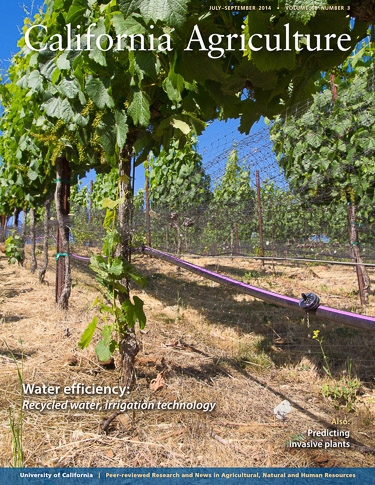New UC research shows recycled water is suitable for Napa vineyards, but adds chloride to Salinas Valley soil.

"This drought is unprecedented — we've never had such a lack of rainfall since we started keeping track," says Doug Parker, who directs UC ANR's California Institute for Water Resources and also leads UC ANR's Strategic Initiative on Water Quality, Quantity and Security. "Farmers are looking for ways they can stretch their water budget."
One way is irrigating vineyards with recycled wastewater from municipal waste treatment plants. California recycles only 7 percent of the 9 million acre-feet of urban wastewater produced per year, and the state wants to nearly quadruple that by 2030. Besides providing a source of irrigation water during drought, recycling water is cost-effective and reduces wastewater discharge to rivers.
To see if recycled water is suitable for use in Napa vineyards, UC Cooperative Extension researchers evaluated the quality of water treated by the Napa Sanitation District (NSD) as well as its impact on soil. They found that the quality of the recycled water was similar to that of other local sources of irrigation water. Additionally, in a vineyard that was irrigated with recycled water for 8 years, the soil did not accumulate salts or toxic ions, such as boron.
"Our work suggests that treated wastewater from the NSD is suitable for irrigation of vineyards over the long term," the researchers say.
One caveat is that the recycled water was relatively high in nitrogen. The higher soil nitrogen levels will be fine for many vineyards but, when needed, growers can easily reduce nitrogen by planting cover crops such as cereals and other grasses during the winter.
Also in this issue:
Recycled water increases chloride in Salinas Valley soil
Most growers in the northern Salinas Valley have irrigated their crops with recycled wastewater since 1998, raising concerns about salt accumulation in the soil. New research shows that since the year 2000, only a small amount of sodium has accumulated in the 12-inch deep rooting zone. In half of the fields studied, chloride has accumulated to levels that could affect yields of strawberry plants and leafy greens such as spinach. This chloride buildup may be due to the recent lack of winter rainfall, which normally washes salts out of the root zone, and could be mitigated by improving drainage and avoiding soil amendments that contain chloride.
Reducing runoff from alfalfa fields
Accounting for nearly 20 percent of total agricultural water use statewide, alfalfa is California's thirstiest crop — large amounts of irrigation water can be wasted as runoff. New UC research shows that alfalfa growers can reduce this runoff to a comparative trickle by using a mathematical model that predicts the advance of irrigation water across a field in combination with wireless sensors that track the water's advance. This new approach also frees growers from checking the irrigation status of fields in person, saving time and labor.
Predicting which plants will invade California
Most ornamental plants are happy to stay in gardens, but some jump the fence, invading wildlands and crowding out native plants. California has a wealth of native plants, about 3,400 species, but is also plagued by more than 1,500 species of invasive plants, many of which were introduced by the horticultural trade. New UC research identifies 186 ornamentals that have invaded Mediterranean areas in other parts of the world, and so are at high risk of becoming invasive here too. This work could help focus further risk assessments of imported ornamentals, as well as help land managers identify which species to watch for in wildlands.
The entire July-September 2014 issue can be downloaded at http://californiaagriculture.ucanr.edu.
California Agriculture is the University of California's peer-reviewed journal of research in agricultural, human and natural resources. For a free subscription, go to http://californiaagriculture.ucanr.edu or write to calag@ucanr.edu.